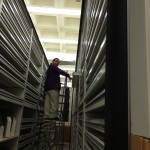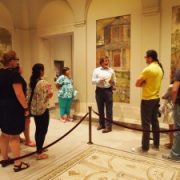“Hey Mom, guess what I did today? I moved a totem pole!”
Special thanks to Summer Olsen, 2013 Smithsonian Affiliations Intern Partner for writing this guest post. Summer spent 10 weeks at the Smithsonian this summer. She returns to California this fall to complete the second half of her intern partnership. Thank you, Summer!
 During my summer 2013 internship through the Smithsonian Affiliations Intern Partnership Program I assisted the Office of the Registrar at the Cultural Resources Center (CRC) of the National Museum of the American Indian (NMAI) from June 3rd to August 9th. Inventory Specialist Heather Farley and Assistant Registrar for Acquisitions Margaret Cintron supervised me. During my internship in Registration I learned about the daily processing, tracking, and inventory of objects in collections, researched Plains beadwork with NMAI curator Emil Her Many Horses, and experienced the organization of other Smithsonian branches via intern tours and events. The skills and knowledge I developed during my internship will be applied to a comprehensive project involving an inventory and assessment of the Plains beadwork collections at the Riverside Metropolitan Museum (a Smithsonian Affiliate) and the museum at Sherman Indian High School in Riverside, California.
During my summer 2013 internship through the Smithsonian Affiliations Intern Partnership Program I assisted the Office of the Registrar at the Cultural Resources Center (CRC) of the National Museum of the American Indian (NMAI) from June 3rd to August 9th. Inventory Specialist Heather Farley and Assistant Registrar for Acquisitions Margaret Cintron supervised me. During my internship in Registration I learned about the daily processing, tracking, and inventory of objects in collections, researched Plains beadwork with NMAI curator Emil Her Many Horses, and experienced the organization of other Smithsonian branches via intern tours and events. The skills and knowledge I developed during my internship will be applied to a comprehensive project involving an inventory and assessment of the Plains beadwork collections at the Riverside Metropolitan Museum (a Smithsonian Affiliate) and the museum at Sherman Indian High School in Riverside, California.
My time at the CRC has flown by and I have developed skills and gained knowledge by completing a variety of tasks: documenting the un-accessioned collections, processing new acquisitions, processing outgoing loans and objects returned from being loaned, working in collections, assisting in the de-installation of an exhibit, and office tasks like scanning and filing catalog cards and accession lot folders.
My main project this summer was to work with two other registration interns documenting the un-accessioned collections. To prepare for our work in registration work we received object-handling training from conservation staff members and training from registration staff to operate work assistance vehicles (WAV) and pallet jacks. We photographed, recorded measurements, and re-housed disassociated fragments from their parent object and un-accessioned material. After photographing the objects we edited the photo files and embedded them with metadata. Then we made custom storage mounts, and shelved the objects in their appropriate locations in collections. I was also taught how to enter some cataloging information and object dimensions into EMU.
We learned to use the barcode system in collections. When working on the documentation project we assigned a barcode to each item. New acquisitions were also assigned barcodes. In addition we re-associated a group of fragments using the barcode system to locate their parent objects and conducted an inventory by scanning the barcodes of un-accessioned works on paper.
 I learned the procedure for processing new acquisitions into the collection. We unpacked crates, took reference photos, and made/wrote condition reports and lot forms. For cloth objects we made tags with NMAI catalog numbers and sewed them down. The procedure was much the same for the outgoing objects for the Anishinabe exhibit at the George Gustav Heye Center in New York City. We checked the condition of each object and compared it to previous condition and conservation reports. When objects came back from a loan I helped Museum Registration Specialist for Loans, Rajshree Solanki, unpack objects and updated their condition paperwork. We also wrote condition paperwork for peace medals that were de-installed at the NMAI Mall Museum in Washington, D.C.
I learned the procedure for processing new acquisitions into the collection. We unpacked crates, took reference photos, and made/wrote condition reports and lot forms. For cloth objects we made tags with NMAI catalog numbers and sewed them down. The procedure was much the same for the outgoing objects for the Anishinabe exhibit at the George Gustav Heye Center in New York City. We checked the condition of each object and compared it to previous condition and conservation reports. When objects came back from a loan I helped Museum Registration Specialist for Loans, Rajshree Solanki, unpack objects and updated their condition paperwork. We also wrote condition paperwork for peace medals that were de-installed at the NMAI Mall Museum in Washington, D.C.
During the second part of my internship I met with NMAI curator Emil Her Many Horses who guided me through NMAI’s beadwork collections. I learned about the progression of beading (from quillwork to early beading to the present day), different cultural styles of beadwork, and beading techniques. The information he imparted will be key to completing my project this fall at the Riverside Metropolitan Museum and Sherman Indian High School.
This internship also gave me access to knowledge via tours of other Smithsonian Museums and events sponsored by the Office of Fellowships and Internships. I was able to see collections storage practices at National Museum of Natural History, the Hirshhorn, and National Air and Space Museum and toured the Folklife festival with curators from the Smithsonian Center for Folklife and Cultural Heritage. The “From Here to Career”, an event hosted by OFI, gave me the opportunity to talk to Smithsonian museum professionals.
My internship at NMAI has been an incredible experience. I will be able to apply all the skills I learned while working at NMAI to my project at the Riverside Metropolitan Museum and Sherman Indian High School. I have been able to see objects I have only ever read about, interact with fantastic people, been given advice that will impact the rest of my academic career, and formed professional relationships. Highlights of my experience have been: Moving a totem pole, documenting strange animal specimens, getting to see collections while re-associating fragments, and learning about beadwork with Emil Her Many Horses.
Thank you Smithsonian Affiliations for this amazing opportunity. I have enjoyed every minute of it and am gearing up to complete the next part of the internship in Riverside.

Summer receiving a Certificate of Award at the Congressional Reception during the 2013 Affiliations National Conference. Left to right: Smithsonian Secretary, G. Wayne Clough; Summer Olsen, Smithsonian Regent, France A. Córdova; Smithsonian Assistant Secretary for Education and Access, Claudine Brown; Riverside Metropolitan Museum Curator of Collections & Exhibitions, Brenda Focht; Riverside Metropolitan Museum Curator of Collections & Historic Structures, Lynn Voorheis; and Smithsonian Affiliations Director, Harold Closter.















